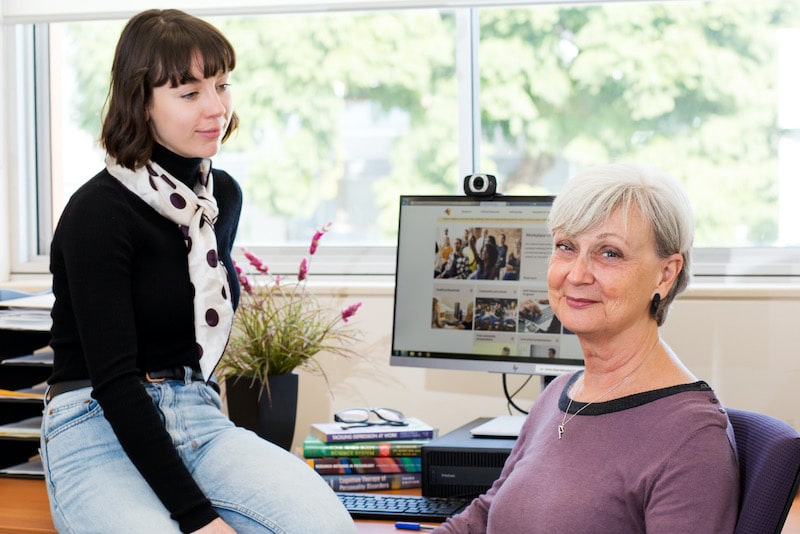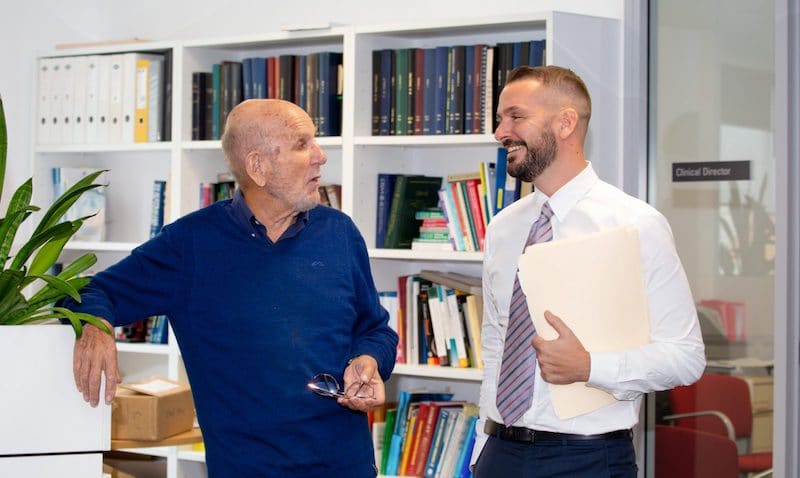A Conversation with Dr. Jan Orman from Black Dog Institute

25 year old Lisa had been struggling with her mental health for over a decade. Over the years, she had seen a host of different psychologists, but struggled to maintain her sessions. As well as struggling with the cost of seeing a psychologist, she found the process of getting to her consultations stressful and daunting. She also found the entire process physically exhausting. At times, she didn’t even have the energy to get out of bed and go to her sessions.
Lisa also found the psychologist’s consulting room somewhat detached from reality. While she felt like she was making progress between the walls of the psychologist’s room, when she left and returned to her normal life, she found it difficult transferring the lessons she had learned.
It wasn’t until a GP recommended some eMental Health resources that everything clicked for Lisa. Working from the comfort of her own home, she began to move through activities around anxiety and stress. Without the high cost of face-to-face contact, Lisa was able to spend more time doing exercises to build up emotional resilience.
She also felt more calm and relaxed when she worked through the activities, which she believes facilitated greater growth. And, because she was working from the environment she lived in, she says it became easier to maintain and ultimately solidify the lessons she was learning.
The rise of eMental Health
Lisa’s story is not everyone’s story. We’re all different. That’s one of the reasons why we have an epidemic of mental health issues in Australia in the first place – because we’re all unique and yet society tends to squeeze us through the same squared hole. Her story is not everyone’s story… but it’s certainly the story of many.
While face-to-face care is ideal for many, it’s not for all. Or at least, it’s not for all, all of the time. Whether a patient has stigma about face-to-face care or can’t deal to step outside their house, whether they can’t afford it or are in a location that doesn’t permit it. There are countless reasons why face-to-face care is not always the best care.
And, with 1 in 5 Australians suffering from mental health problems in any given year, there is the sheer reality that there are more people who need help than there are people who can help. If everyone who needed help sought face-to-face care, it simply wouldn’t be possible. The whole system would become clogged.
For all of these reasons, we are witnessing the rise of eMental Health resources. Sure, this stuff isn’t new – the first Australian online eMental Health treatment was launched all the way back in 2001 – but online treatments are certainly growing. Today there are hundreds of evidence-based programs.
Some have become so fine-tuned that, for the first time ever, the College of Psychiatry’s clinical practice guidelines recommends digital cognitive behavioural therapy as the first course of action in the stepped-care model for anxiety.
To learn more about the role of eMental Health resources in Australia and how GPs can make better use of these resources, I sat down with Dr. Jan Orman – a psychological medicine practitioner in Sydney’s inner west and a GP educator for Black Dog Institute.

Meet Dr. Jan Orman
After gaining her residency as a GP, Dr. Jan Orman developed a passion for the counselling aspects of general practice with a special interest in mental health. After completing a Masters of Psychological Medicine in Cognitive Behavioural Therapy, Dr. Jan Orman became one of the first facilitators in the professional education team at Black Dog Institute – an Australian not-for-profit facility for diagnosis, treatment and prevention of mood disorders.
Since 2013, Jan has been involved in the ‘eMental Health in Practice Project’ (eMHPrac) where she delivers educational programs to GPs on eMental Health. Regularly presenting on the topic of eMental Health, she has become one of Australia’s leading mental health advocates with her views appearing in publications by Health Times, Australian Doctor and RACGP to name a few.
The following is an interview with Dr. Jan Orman.
How would you describe the state of Australia’s mental health?
“Look, we do know that the Australian population has a considerable load of mental health problems. The issue with mental illness is that people tend to define it in terms of the pointy end of mental illness. Yes, there are 1% of the population who suffer from schizophrenia and 3% to 5% of the population who have bi-polar disorder, but that’s not all we’re talking about when we talk about mental illness.
We’re also talking about the common mental health conditions, like depression, anxiety and the consequences of stress in people’s lives. So in the end, the figure that comes out is that 1 in 5 Australians suffer from some level of mental health condition annually. Some of those conditions are episodic. So, not the same people will make up the figures every year, but 1 in 5 is quite a lot of Australians who need mental health help in any given calendar year.
How would you describe our treatment of mental health?
“Well, we know that many of those Australians with mental health needs don’t seek help for a variety of reasons. Stigma is way up on top of that list of reasons, but other issues include the perception that help is not available, the actuality of help not being available for geographic or financial reasons, or simply things like the help not being available after working hours.
The Health of the Nation Report, commissioned by the Royal Australian College of General Practitioners in 2018, revealed that 62% of general practitioners consultations were about mental health. And, if that GP happened to be female, then it was 67% of general practice conditions.
So those people who are seeking help are often going to their GP in the first instance, and the fact of the matter is that they need to go to their GP if they want to get help from a psychologist or a psychiatrist and receive a Medicare rebate. So GPs are the gateway to those services. That tells you something about the load of mental health care for general practitioners and why GPs need to perhaps do more about mental health than they already do.
Are GPs using eMental Health resources? What are some of the flagship resources out there?
“One of the problems is that GPs don’t know what to do in the face of mental health issues. The focus of education tends to be on mental health crises and severe mental health conditions. Lots of GPs, though they’re not wildly comfortable with the idea, know how to manage crises. It’s the ordinary everyday mental health conditions that GPs don’t necessarily know what to do with beyond prescribing or referring to someone.
When I first started talking to GPs and primary care clinicians of all sorts about online resources for mental health – that was say, back in 2013 – not many people knew anything about them at all, which is a bit of a shame really because the first Australian online eMental Health treatment was actually launched in 2001. So that’s 12 years before I started talking to people about it through the ‘eMental Health in Practice Project’.
So there are a lot of gaps in knowledge there and that is very dissatisfying for someone who’s keen to help people know about new things. But the ‘eMental Health in Practice Program’ has now been running since 2013 and we’ve got the message out to lots and lots of GPs and allied mental clinicians via a number of pathways.
We’ve been doing face-to-face presentations, webinars, podcasts… we run a mental health community of practice online that clinicians can join in order to talk in forums about various issues. So that means the eMental Health message is getting out there and people tend to know that these programs and resources exist.
The Federal Government launched a fantastic portal at the end of 2017 called Head To Health. It’s a repository of all the reliable Australian-built mental health resources available to people. It’s a community-facing portal where members of the community and health professionals can find reliable online resources.

I think confidence is growing in the reliability of these resources as more and more research is made available about their reliability and efficacy. What’s still lacking for GPs and other primary care mental health workers is confidence in knowing how to encourage people to engage with and continue to engage with online resources. That’s mostly what I talk about these days – how to encourage people to use them – rather than in the first instance where I was acquainting people with the existence of these resources.”
In one of your talks, you describe how not every patient who comes to a GP with a mental health issue needs to be directed to a psychologist. Can you explain this more?
“There’s been a real problem in mental health care in that because the assumption is that if you come to the GP, you are after a referral or a prescription, and because GPs don’t necessarily know what else to do – I certainly didn’t’ know what to do with all these people who were coming to me for counselling before I did my Masters – then referrals are what they get.
Now people will tell you, especially in rural Australia, that they can’t get into a psychiatrist or a psychologist for many weeks or sometimes months, and basically the fact that everyone’s getting a referral, irrespective of the severity of their illness, means that the whole system gets clogged up.
What the stepped-care model of mental health delivery is encouraging people to do is find appropriate treatment pathways to match the severity of the illness. So a lot of people can manage less severe illnesses with self-help.
One way of thinking about online treatment programs and resources is as the online equivalent of self-help books because they encourage people to help themselves. This is a good thing because if you find ways of helping yourself, you have a much greater sense of self-efficacy and that in itself can promote your mental health.
Severity isn’t the only thing that determines whether someone should be referred to an online program. Some people simply want to see a person and that’s perfectly reasonable as well. Patient preference should be at the top of the list when you are discussing therapy options with patients.
Having said that, there are a number of people who have higher severity illnesses who don’t want to talk to a person and there’s no reason why they can’t be referred to online treatment programs as a taster. A lot of people have funny ideas about what face-to-face therapy is about. You know, people might read their minds, know what they’re thinking etc etc.
A little bit of cognitive behavioural therapy experience online will often settle their nerves about what will happen when they go to face-to-face therapy. And also, if they do a little bit of cognitive behavioural therapy online, they will be better prepared for what the face-to-face therapy has to offer them. This means they can make more efficient use of the sessions that are available to them when they do see a therapist face-to-face.
What are GPs biggest criticisms of eMental Health? What are your answers?
“Well, in the first instance, GPs were saying to me, “How can we trust it? How do we know it’s reliable?” But if GPs look at the evidence they will see that the Australian evidence-based programs are very trustworthy. They are very unlikely to cause harm, which of course is the most important thing the doctor is concerned about.
These days, GPs say to me, “But I can’t get people to do them. I tell them to do them and they don’t comply. They never even look at them”. I say there are a considerable number of strategies GPs and other people working in mental health can use to increase the likelihood that patients will use the online resources and use them effectively.
To encourage engagement, at the time of recommending a program, I suggest making a follow-up appointment for a week or two later to make sure the patient is engaged with the program and that it’s the right program for them. You can also show them the program on the computer in your consulting room, and even help them register.
Other ways to encourage engagement is to discuss when and where the patient can do the program. If possible, you could also send them an SMS containing a link to the program.
The other concern that GPs have is that people can find terrible things online. They can find websites that have instructions around suicide, for example. And, because of this they say, “I don’t want to send people to the internet”.
All I can say is that you’re kidding yourself if you think people don’t go to the internet anyway and surely it’s better that people go to the internet and look at things that have been recommended and that are known to be reliable and evidence-based.
Can you explain a little about Black Dog’s myCompass program?
“Well, here at Black Dog, just to explain a bit, we have a whole range of things that fall under the digital mental health banner. myCompass is an example of that. myCompass is an online self-guided cognitive behavioural therapy based program for people with mild to moderate anxiety, depression and stress.
It’s a trans-diagnostic program so everybody, irrespective of their diagnosis, can do the same program and learn skills for management of their various symptoms associated with image or health problems.
The evidence for it has been collected in a randomised-controlled trial and there is a lot of anecdotal evidence that people like it and it helps them with their mental health problems. Like all of these treatment programs, there is a registration process, but it’s not very onerous. Then people can launch themselves into the program.
myCompass is different to most programs in that it has an arrangement of activities, if you like, and those activities are based on people’s symptoms and their needs. People can complete them in any order that they like.
Usually, if someone goes into an online treatment program with a problem with their sleep, for example, then unless the program is a specific sleep-related problem, they have to work their way completely from beginning to end through a cognitive behavioural therapy program for everything. But with myCompass, people can choose specifically to do the sleep activity and that applies to any of the other activities.
There are 14 activities and they can do them in any order they like. So they can cut to the chase straight away. That’s not to denigrate the other programs in any way. There are a lot of very good programs out there. But for people who are particularly concerned about one specific aspect of their functioning, myCompass is a good option.
Can you explain a little about Black Dog’s BITE BACK program?
“Black Dog has a terrific website for adolescents called BITE BACK, which is a positive psychology based website that adolescents can go on and learn a whole lot of things, including gratitude and mindfulness. All the things that positive psychology likes to teach.
On the website there is also a structured mental fitness program. It’s a challenge where people are asked to do 6 weeks of specific exercises for each week, and I can tell you that it’s great, not just for 16-18 year olds, but also for people nearing retirement, like me. When I did the program, I learned a great deal about my own mental health, so it’s an excellent program to recommend people do.
I’ll get into trouble if I just talk about Black Dog programs because there are lots of other programs out there that people find useful, but we probably don’t have time to talk about all of them.
What are your thoughts on This Way Up?
“This Way Up is another program that’s a little bit different from the other programs. It is a diagnosis specific program. I mentioned that myCompass was trans-diagnostic and you can do it irrespective of your diagnosis. This Way Up is a program that contains, I think it’s 11 courses and 3 shorter courses, that are about specific diagnoses. So the person goes in and does the registration process, which consists of a short questionnaire and those questionnaires suggest that maybe they need a social anxiety program or a depression program or an OCD program.
Mind you, the person can sign up for any program they like. They don’t have to follow the recommendations. So, that’s one way in which This Way Up is a little bit different from the other programs.
The other way that it’s different from the other programs is that you have to pay for it. All the other Australian programs are free, but This Way Up costs $60 for each course. But if you finish your course, it’s available to you 12-months after you finish the course. So it’s there for a while for revision and reinforcement.
Having said that, there are three absolutely free courses. They’re the shorter courses that I mentioned.
One of the most valuable free courses is the insomnia course. GPs often have great difficulty spending the necessary time to help people with sleep difficulties. The insomnia course will reinforce the things that they’re teaching their patients about sleep hygiene, but will also go beyond sleep hygiene and teach them things that maybe GPs don’t know and maybe GPs don’t have time to teach.

Above: This Way Up’s founder, Professor Gavin Andrews (left), and Clinical Director, Dr. Michael Millard (right). Read our full interview with Dr. Michael Millard
You know back earlier in our conversation I mentioned all the people who have problems but can’t get to see someone about them because they work in the same hours that their practitioners work? That’s where eMental Health comes in and something like the insomnia program is a great way for a patient to occupy their non-sleeping hours. Instead of lying awake stressed they could hop online and do some work on their insomnia.
Do you have any parting words for GPs when it comes to eMental Health?
“I think the most important message for GPs is that (1) the research shows these programs work, (2) the programs add to your efficiency as a GP by teaching patients the skills you otherwise might have to teach them. And (3) while it takes a bit of time to get familiar with the eMental Health programs, once you’re familiar with them, they become fantastic additions to your toolbox in terms of taking care of patients with mental health problems, as the 62% of people who walk through your door need you to do.
One other thing is that no one’s going to engage with online mental health programs unless the person who refers them is enthusiastic and knowledgeable about the program. I think that’s the bottom line for GPs – help your patients engage with and adhere to the programs with your own knowledge and enthusiasm.



